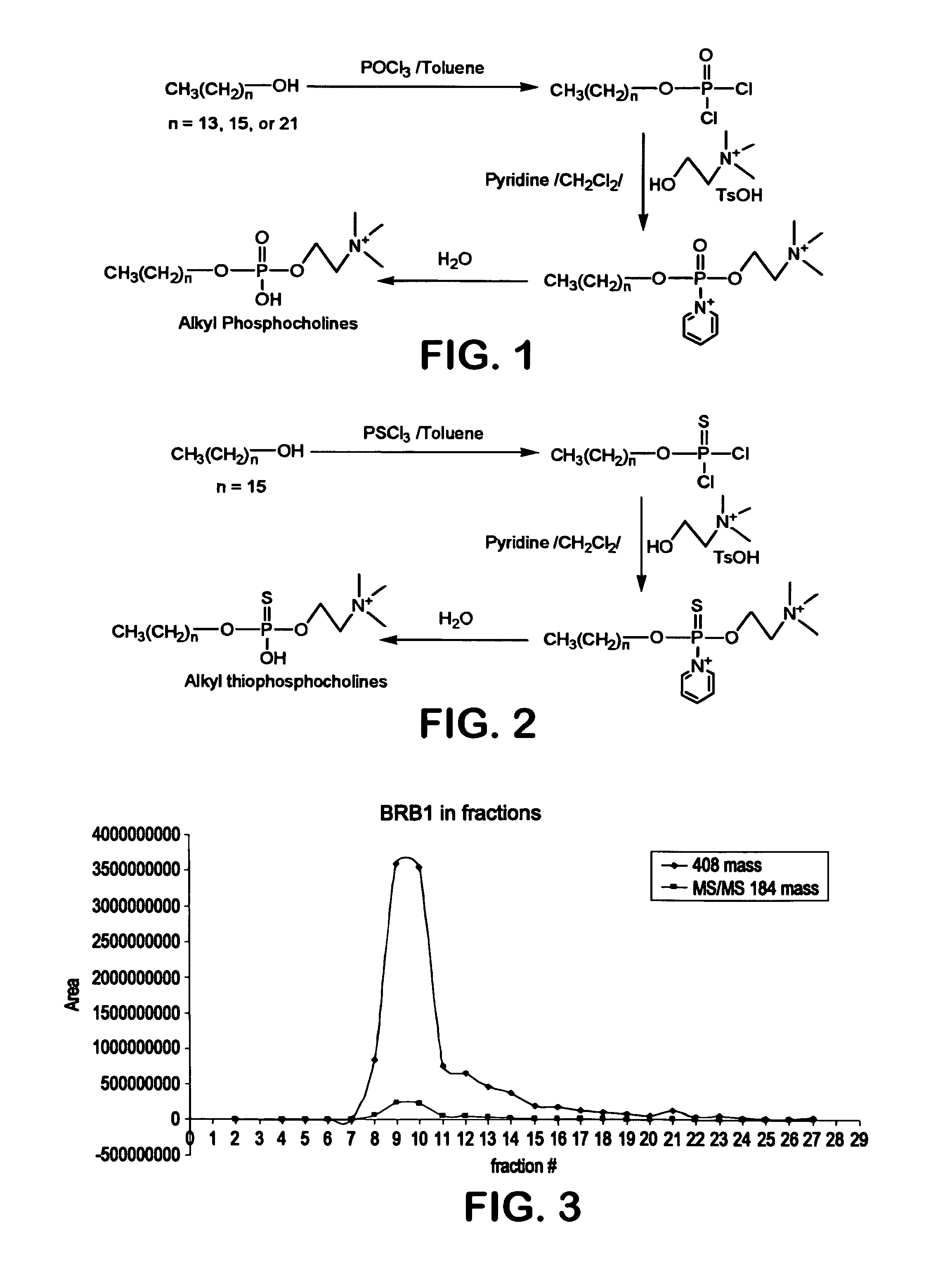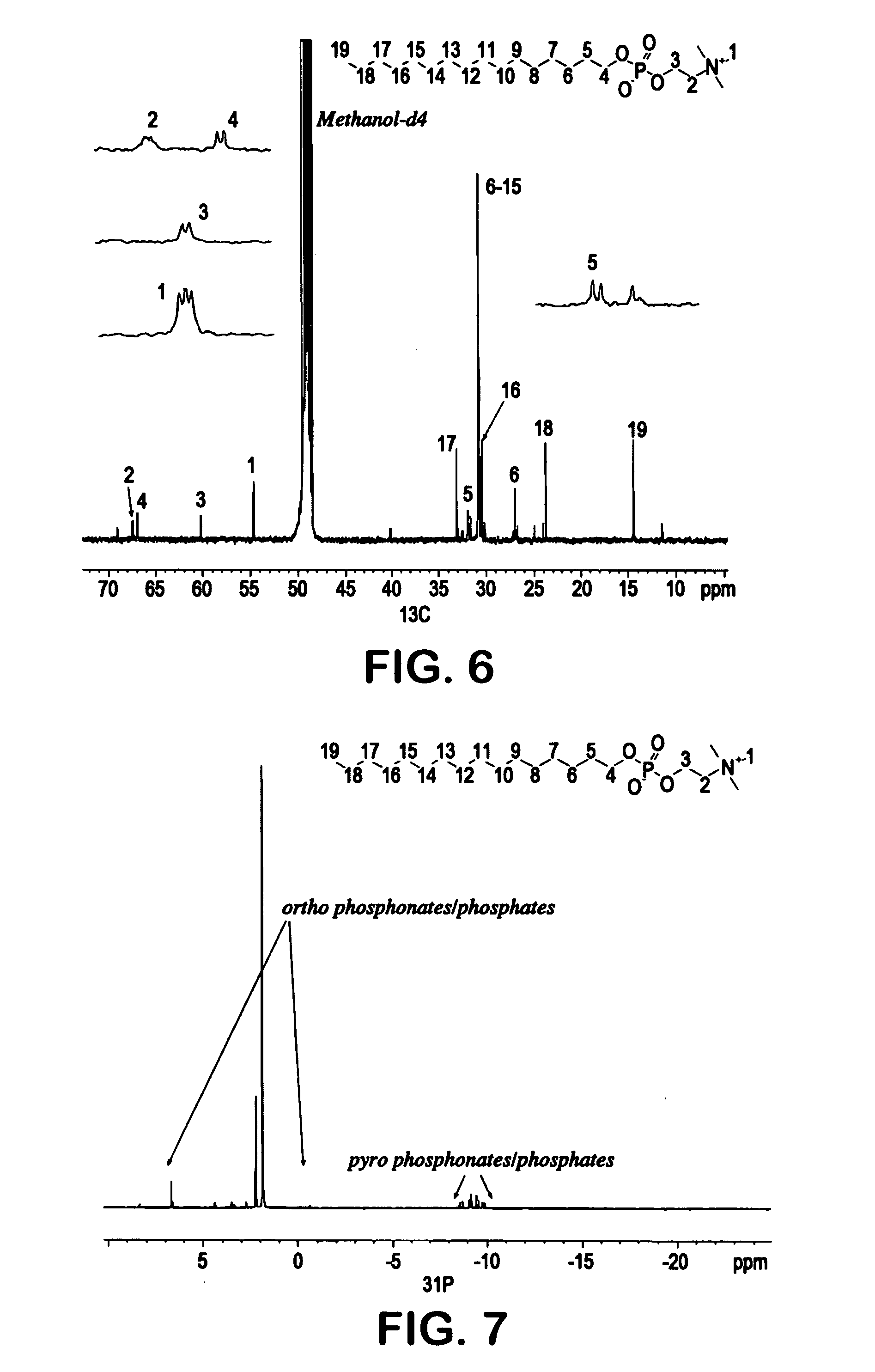Mucosal formulation
a technology of mucosal and mucosal powder, which is applied in the field of mucosal powder, can solve the problems of increased moisture, vaginal atrophy, incontinence,
- Summary
- Abstract
- Description
- Claims
- Application Information
AI Technical Summary
Benefits of technology
Problems solved by technology
Method used
Image
Examples
example 1
[0087]Various phosphocholine derivatives were synthesized using a three-step process as shown in FIGS. 1-2. Specifically, 0.484 grams of hexadecanol (n=15) (from Aldrich Chemical Company) was mixed with 20 milliliters of toluene and 100 milliliters of phosphoryl chloride (“POCl3”). The mixture was heated in an oil bath at 87 to 90° C. for 5 hours. After cooling to room temperature, the reaction mixture was concentrated in vacuum. 50 milliliters of methylene chloride and 1.38 grams of choline tosylate were then stirred into the mixture at room temperature for 40 to 50 hours. This reaction mixture was concentrated by a rotavaporator and the resulting residue was mixed with 1.5 milliliters of water. The residue was stirred at room temperature for 5 hours and concentrated with a nitrogen stream to give crude hexadecyl phosphocholine. Tetradecyl phosphocholine (C14 chain) and docosanoyl phosphocholine (C22 chain) were also synthesized using the technique described above, except that tetr...
example 2
[0089]The crude hexadecyl phosphocholine (BRB-1) of Example 1 was purified using a Diaion® HP-20S synthetic adsorbent polystyrene resin (Mitsubishi Chemical Corp.). The column fractions were then collected with water, methanol:water (1:1), and methanol. The collected fractions were analyzed using liquid chromatography / mass spectroscopy (“LC / MS”) and the results are shown in FIG. 3. IR and NMR (proton, carbon and phosphorus) spectral analysis was performed and the results are shown in FIGS. 4-7. The structure of hexadecyl phosphocholine was confirmed by the spectral data shown in FIGS. 3-7. Similarly, tetradecyl phosphocholine (BRB-3) and hexadecyl thiophosphocholine (BRB-3) of Example 1 were purified as described above. The collected fractions were analyzed using liquid chromatography / mass spectroscopy (“LC / MS”) and the results are shown in FIGS. 8-10. These figures confirm the structure of tetradecyl phosphocholine and hexadecyl thiophosphocholine.
example 3
[0090]The ability of the phosphocholine derivatives of Examples 1-2 to inhibit growth of Candida albicans, Staphylococcus aureus, Lactobacillus acidophilus, and Gardnerella vaginale was tested. Each phosphocholine derivative (at concentrations ranging from 0 to 500 micrograms per milliliter) was dissolved into a broth media and 6 wt. % ethanol. Thereafter, 0.1 milliliter of each solution was inoculated in 1.0 milliliter of a growth media containing the microorganism of interest. The growth media was TSB media for Candida albicans and Staphylococcus aureus, MRS broth for Lactobacillus acidophilus, and NYC-3 broth enriched proteose peptone for Gardnerella vaginale. The concentration of the microorganism in the growth media was 104 colony forming units (“CFU”) per milliliter.
[0091]Thereafter, the gross turbidity of the media was monitored at 24, 48, and 72 hours time intervals. Gross turbidity is an indicative of growth inhibition and is determined using visual determination or a spect...
PUM
| Property | Measurement | Unit |
|---|---|---|
| time | aaaaa | aaaaa |
| pH | aaaaa | aaaaa |
| size | aaaaa | aaaaa |
Abstract
Description
Claims
Application Information
 Login to View More
Login to View More - R&D Engineer
- R&D Manager
- IP Professional
- Industry Leading Data Capabilities
- Powerful AI technology
- Patent DNA Extraction
Browse by: Latest US Patents, China's latest patents, Technical Efficacy Thesaurus, Application Domain, Technology Topic, Popular Technical Reports.
© 2024 PatSnap. All rights reserved.Legal|Privacy policy|Modern Slavery Act Transparency Statement|Sitemap|About US| Contact US: help@patsnap.com










